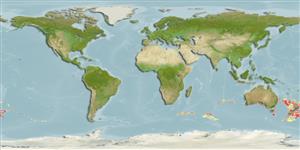Common names from other countries
Holocephali (quimeras) (chimaeras) >
Chimaeriformes (Chimaeras) >
Chimaeridae (Shortnose chimaeras or ratfishes)
Etymology: Hydrolagus: hydro-, combining form of hydor (Gr.), water; lagos (Gr.), hare, i.e., “water rabbit,” probably referring to three pairs of tooth plates, which tend to protrude from the mouth like a rabbit’s incisors. (See ETYFish); homonycteris: homo-, from hominis (L.), man; nykteris (Gr.), bat, referring to Thomas A. Griffiths, bat systematist known as “bat man,” who introduced Didier to chimaeroid fishes. (See ETYFish).
Environment: milieu / climate zone / depth range / distribution range
Ecologia
marinhas batidemersal; intervalo de profundidade 866 - 1447 m (Ref. 76967). Deep-water
Southern Ocean: Australia and New Zealand.
Comprimento de primeira maturação / Tamanho / Peso / Idade
Maturity: Lm ?, range 85 - ? cm
Max length : 109 cm TL macho/indeterminado; (Ref. 76967)
Descrição suscinta
Chaves de identificação | Morfologia | Morfometria
This chimaeroid fish has a ventral caudal fin that that is not indented at its origin to form a separate anal fin, it is distinguished from its congeners by the following characters: color of the body an even dark black or blackish-brown; its dorsal fin spine is longer than height of first dorsal fin; pelvic fins is distinctly round in shape; males with pelvic claspers that are dark at the base with pale tips, divided for the distal 1/3 of their length (Ref. 76967).
Ciclo de vida ou comportamento de acasalamento
Maturities | Reprodução | Spawnings | Egg(s) | Fecundities | Larvas
Didier, D.A., 2008. Two new species of the genus Hydrolagus Gill (Holocephali: Chimaeridae) from Australia. In Last, P.R., White, W.T. & Pogonoski, J.J. (eds.): Descriptions of New Australian Chondrichthyans. CSIRO Marine and Atmospheric Research Paper no. 22. (Ref. 76967)
Status na Lista Vermelha da UICN (Ref. 130435)
CITES (Ref. 128078)
Not Evaluated
Ameaça para os humanos
Harmless
Uso pelos humanos
Ferramentas
Relatórios especiais
Baixar XML
Fontes da internet
Estimates based on models
Preferred temperature (Ref.
115969): 2.2 - 5.7, mean 4.6 (based on 177 cells).
Índice de diversidade filogenética (Ref.
82804): PD
50 = 0.5000 [Uniqueness, from 0.5 = low to 2.0 = high].
Bayesian length-weight: a=0.00275 (0.00138 - 0.00549), b=3.08 (2.90 - 3.26), in cm Total Length, based on LWR estimates for this species & (Sub)family-body (Ref.
93245).
Nível Trófico (Ref.
69278): 3.9 ±0.6 se; based on size and trophs of closest relatives
Resiliência (Ref.
120179): Muito baixo(a), tempo mínimo de duplicação da população maior que 14 anos (Preliminary K or Fecundity.).
Fishing Vulnerability (Ref.
59153): High to very high vulnerability (65 of 100).
